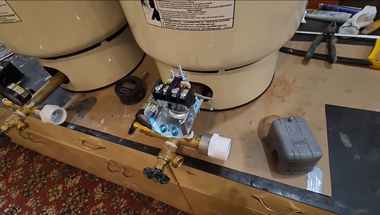Replacing a faulty pressure switch typically resolve issues surrounding low water pressure, irregular water supply, etc. However, if it does not, figuring out the cause can be really baffling.
But what is the solution for a replaced pressure switch and still no water?
Oftentimes, the water supply is poor even after replacing the pressure switch. This occurs due to clogged filters, bad pumps, and many more. However, the solution to these problems is quite simple.
This article will address some of the common causes of no water after installing a new pressure switch. We will also provide the steps to diagnose and resolve the issue easily. Read the guide till the end!
Possible Causes And Their Solutions
We have made a quick table regarding the reasons behind no water supply even after changing the pressure switch. We have also accumulated their possible solutions here for a quick understanding.
| Problems | Solutions |
| Clogged Filters | Clean or replace the filters |
| Leaking Pipes | Repair the leaks properly |
| Malfunctioning Pump | Repair or install a new pump |
| Low Municipal Water Supply Pressure | Contact the municipal supply or install a booster pump |
| Blocked Well Screens | Clean the good screens |
Reasons Behind Replaced Pressure Switch And Still No Water

There are quite a few reasons why the water supply remains off even after you change the pressure switch connected to the system. Check out the top issues and how you can fix them easily.
1. Clogged Filters
Water filters or filtration systems connected to the water supply often become clogged over time. This blockage happens due to the presence of dirt, dust, sediment, and so on.
Rust, debris and other contaminants are also responsible for the trouble. And when the filters are blocked, they restrict the flow of water.
How To Solve It?
Check the filters connected to the system and see whether it is clogged or not. Make sure to clean the filters to remove the accumulated contaminants or install a new filtration system.
2. Leaking Pipes
Leaks in the pipes occur due to corrosion or rust. The water traveling through the pipes escapes through the leaks, which in turn reduces water pressure. Not only that, but it also prevents water from reaching the faucet in your home.
How To Solve It?
Inspect the plumbing system for leaks. To do so, inspect all visible pipes around the house for signs of water damage or dripping.
You can also check the water meter to ensure that it is still running after turning off all taps, faucets, etc. If there is a leak in the system, make sure to get it repaired with the help of a professional plumber.
3. Malfunctioning Pump
The water pump is one of the most crucial components in a plumbing system. It is usually responsible for providing water to your home. If the water pump fails to supply water properly or stops working, there will be no water.
How To Solve It?
First, check the water pump properly and ensure it is properly working. For inspection, check the water pressure with a pressure gauge. You can listen for any strange or unusual noises coming from the pump.
Lastly, check the wiring connected to the pump. Repair the component once you have identified the problem, or install a new one by removing the damaged one.
4. Low Water Pressure From The Municipal Supply
If the pressure of water from the main water supply system is quite low, it will significantly affect the water pressure in your home.
How To Solve It?
To check for low municipal water pressure, measure the water pressure in your home with a pressure gauge. Compare the pressure to a neighboring home. You can also contact the municipal office or local water supplier regarding the issue.
If the low water pressure is confirmed, you will probably have to rely on a booster pump to improve the condition.
5. Blocked Well Screens
Similar to water filters, well screens can become clogged. This blockage typically happens due to the presence of dirt, dust, sediment, and many more. These contaminants lead to a reduction in the water flow into the home.
How To Solve It?
Check the well screens and see whether they are blocked or not. Inspect the casing and surrounding area of well for any signs of blockage caused by sediment, dirt, etc. Contact a professional and get the clogged well screens cleaned to fix the issue.
FAQs
Still got questions or confusion regarding the irregular water supply problem? Give these frequently asked questions a read to get a clear understanding of the topic!
If you are confused about whether the water pump or switch is malfunctioning, check the pump first. Inspect with a pressure gauge and keep an ear out for strange or unusual sounds.
Do not forget to check the tripped circuit breakers. Lastly, check the pressure switch for its functionality if the pump is working.
Yes, leaking pipes on your own is possible if you have proper knowledge about the plumbing system and pipes. However, we typically recommend relying on a professional for the work to prevent further damage.
Final Words
Problems with the plumbing system and water pump are nothing new and often frustrating. If you have replaced pressure switch and still no water comes out of the faucets, the reasons mentioned above are responsible.
Make sure to conduct the necessary inspections and if necessary, solve the issues with the help of a professional. Moreover, make sure to keep your filters regularly clean as a maintenance practice. With that being said, hope you were about to help, and good luck!
Further Read:
Can You Get City Water If You Have a Well?